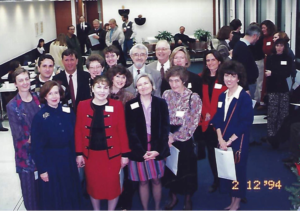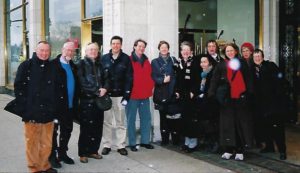
By Emily Clott, Class of 2012
This, the Year of the Docent, marks 50 years since the first docent class of the Chicago School of Architecture Foundation completed training. A graduation ceremony was held at the Chicago Public Library on a June 21, 1971. That first class of 31 gave tours of Glessner House and Loop skyscrapers. These tours supported the organization’s mission to raise both public awareness and funds to fight the threat of demolition of landmark residences and early skyscrapers.

The idea to train tour guides was borrowed from the Gamble House in Pasadena, California, a house-museum that trained volunteer guides called docents. The word “docent” is derived from the Latin word docere, to teach; it typically refers to volunteers who conduct tours in art galleries and museums.

Architectural historians Paul Sprague and Carl Condit conducted the 1971 class, held at Glessner House. Condit authored The Chicago School of Architecture, and the program emphasized knowledge of architecture. Do you think the training is tough today? Early docent classes consisted of lectures, readings, homework, bus tours of the city, oral and written exams, and a thesis project!
Within two years docents strengthened the organization’s mission by creating new tours in neighborhoods—Hyde Park, Oak Park, and North Michigan Avenue. Their training had equipped docents to create accurate and informative, but never scripted tours. By 1976, the Foundation and the docent program had grown, with roughly 200 people completing the training.
Candidate Selection
From the beginning, people from all walks of life have applied to take docent training, most with little or no background in architecture or Chicago history. The process of selecting docent candidates has evolved over time. At first, interviews were conducted by the staff volunteer coordinator who decided if a candidate was docent material. Later, staff and docents together designed a more targeted and less subjective interview process. Today, a panel of two trained docents and the volunteer coordinator ask all candidates the same questions that are then scored on a scale of 1-5. Each candidate presents a three minute talk on a specific building that is also scored numerically, thereby standardizing the process.
It has always taken a village to raise a docent. For this story, I spoke with past and present staff members Pat Patterson, Barbara Gordon, Jason Nieses, Hallie Rosen, Jen Masengarb and Adam Rubin, as well as Docent Education Committee leaders Jane Buckwalter, Donna Gabanski, Dan Fitzgerald, Kathy Baker and Lisa Voigt to get a sense of how our program has changed to adapt to changing times and the needs of the organization.
A Painful Transition
While Pat Patterson was Coordinator (1991-96), CAF separated from Glessner House, a painful transition for some founding docents. Also during her time, the official River Cruise partnership with Chicago’s First Lady began. Pat had to try to determine when interviewing candidates whether they were serious about volunteering for CAF, rather than to use our training to help secure paying gigs for river competitors.

Pat hired Barbara Hrbek Gordon in 1994 when all staff offices fit into the first floor space at 224 S. Michigan. She asked Barb to take the docent training, and by 1996 Barb succeeded her as volunteer coordinator. Subsequent volunteer coordinators Jason Nieses (2001-2011) and Hallie Rosen (2011-2017) also became docents. By participating in the program themselves, they could learn the basics of architecture and Chicago history and better identify with the work load and stresses trainees can experience. Barb Gordon worked with the Education Committee led by Jane Buckwalter to further reduce the load: the final project, akin to a master’s level thesis, was phased out as the topics were often unrelated to tours. Oral and written exams were discontinued, and eventually homework could be submitted on-line.

Until 2001, trainings were offered in the fall. Jason observed that because the fall training finished just as the tour schedule slowed for the winter season, newly minted docents struggled to schedule tours. He discontinued fall trainings, and instead Thursday and Saturday sessions were held from January to April, so that new docents were ready to hit the streets in late spring, when the tour schedule greatly expanded.
New Scholarship
By 2000, CAF’s purpose had changed. Significant buildings like the Monadnock, the Fisher, and Glessner House were no longer under threat. Jen Masengarb joined the staff, armed with degrees in architecture and American history and an M.A. in architectural history and historic preservation. Her presentations to the trainees clustered material according to theme; she offered lectures on ornamentation and the visual aspects of architecture, another on building structure, a third on systems of the building. And she added content on history and architects.
Jen worked with the Education Committee to design a new syllabus that included readings reflecting new scholarship and social issues, including the role of women in architecture. Activities tied to the readings were developed, a methodology that supported new learning.

In the summers of 2008-2009, Jen led workshops for teachers that were funded by the National Endowment for the Humanities. In addition to readings, she invited top scholars—Joanna Merwood, Tom Leslie and Paul Steinbrecher—to address attendees. These notable lecturers and others were also invited to address docent classes.
Themes, Storytelling and Redesign
Developing themes that gave a tour coherence was an important element of docent training. Hallie Rosen introduced the idea of storytelling in 2012, and she invited the late Syd Lieberman to demonstrate how stories could enhance their tours.
Through the long tenure of Jane Buckwalter’s leadership of the Education Committee, standards continued to evolve. The Docent Peer Review Program ensured that tours maintained excellence. Continuing education through seminar and refresher programs were offered. Mike Cohen created feedback training to enable readers, sponsors and certifiers to constructively review docent performance, and the Ed Committee surveyed trainees to determine what worked and what didn’t after each class session.
By summer, 2013, there was an active corps of almost 400 docents, all of whom were trained to give the Historic and Modern tours downtown. These tours were offered daily, yet many docents struggled to fulfill their 10 tour obligation, while other tours lacked sufficient docents to fill their schedules. Thus, the Education Committee and Jen Masengarb decided not to hold training in 2014. Instead, the year was devoted to entirely redesigning docent training. Training would begin with an orientation to CAF, its mission, organizational structure, docent governance, etc. The first five weeks of class, called Fundamentals of Architecture, used 10 buildings as case studies to study Chicago and its built environment. These buildings would illustrate basic architectural vocabulary, the story of the city, architectural styles, and engineering challenges among others. These fundamentals were basic to any tour in CAF’s portfolio. In the final five weeks, trainees would learn specific tours, choosing from several offerings. This enabled the training to better meet the demands of the market.
The Move
In 2018 the CAF transitioned to CAC and moved to 111 E. Wacker, disrupting training that year. As the 2020 class was getting started, the pandemic hit. Docents learned new skills, adapting content to be delivered virtually, and using technology to connect trainees with their sponsors via Zoom. Training of the 2020 class has resumed, and a fresh cadre of docents will be ready to hit the streets when the Center re-opens and the schedule expands this summer. Caroline Duda, current Volunteer Manager and docent wrangler is back from maternity leave just in time to mentor trainees of the class of 2020/21.
 Adam Rubin, Director of Interpretation, suggests we expand our conversation about architecture to include urban literacy, street infrastructure, landscape architecture, and climate change. Unrest during the summer of 2020 underscored the need to re-frame the content we present as well as to diversify the age, race, background, and neighborhood makeup of the docent body. We can anticipate further changes in the selection and training processes.
Adam Rubin, Director of Interpretation, suggests we expand our conversation about architecture to include urban literacy, street infrastructure, landscape architecture, and climate change. Unrest during the summer of 2020 underscored the need to re-frame the content we present as well as to diversify the age, race, background, and neighborhood makeup of the docent body. We can anticipate further changes in the selection and training processes.
Like a great building, the foundation of our training program has been solid, sustaining us with lasting values of civic pride, life-long learning, camaraderie, and the volunteer spirit. Congratulations to all the women and men who have brought us to this auspicious 50-year milestone! Here’s to 50 more!





TERRIFIC history lesson … THANK YOU Emily!!!
Help!! I am currently an Education Guide but I was trained as a docent in the class of ’83 or ’84. I gave tours (Loop, FLW in Oak Park and near west side) for a few years but life took over and I did not stay current. Are there any docents out there from that time? I lost all my notes and info and i cannot remember any of my classmates. I even forgot the name of our CAF contact. Let me know if I can reconnect with some of you. Thanks….JP
Incredible amount of research that flowed like the cast iron during THE Fire! Bravo!
Kudos to Emily for a well-researched and interestingly written history of CAF/CAC..
@John
I trained in 1984 (Saturday class). One other docent from my class is still active: Kathy (Laughman) Maynard. – Michael Weiland, ’84
Super job Emily! I learned a lot. I was wondering what can you tell us about the present whereabouts of my mentors, Barbra Hrbek Gordon, Jason Neises, and Hallie Rosen?